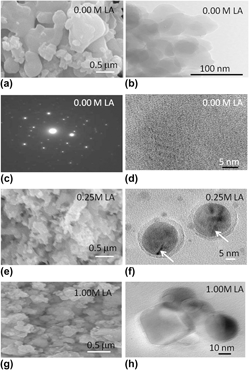Crossref Citations
This article has been cited by the following publications. This list is generated based on data provided by
Crossref.
Liu, Yong Gang
Wang, Yao Wu
Fang, Mou
Shang, Yu Ming
Zhao, Xiao
Zhang, Li
and
Jiang, Jin Zhi
2013.
Effect of Heat-Treatment Condition on the Morphology and Electrochemical Property of LiFePO<sub>4</sub>.
Applied Mechanics and Materials,
Vol. 291-294,
Issue. ,
p.
712.
Dhindsa, K.S.
Mandal, B.P.
Bazzi, K.
Lin, M.W.
Nazri, M.
Nazri, G.A.
Naik, V.M.
Garg, V.K.
Oliveira, A.C.
Vaishnava, P.
Naik, R.
and
Zhou, Z.X.
2013.
Enhanced electrochemical performance of graphene modified LiFePO4 cathode material for lithium ion batteries.
Solid State Ionics,
Vol. 253,
Issue. ,
p.
94.
Radhamani, A.V.
Karthik, C.
Ubic, R.
Ramachandra Rao, M.S.
and
Sudakar, C.
2013.
Suppression of antisite defects in fluorine-doped LiFePO4.
Scripta Materialia,
Vol. 69,
Issue. 1,
p.
96.
Bazzi, K.
Mandal, B.P.
Nazri, M.
Naik, V.M.
Garg, V.K.
Oliveira, A.C.
Vaishnava, P.P.
Nazri, G.A.
and
Naik, R.
2014.
Effect of surfactants on the electrochemical behavior of LiFePO4 cathode material for lithium ion batteries.
Journal of Power Sources,
Vol. 265,
Issue. ,
p.
67.
Orvananos, Bernardo
Malik, Rahul
Yu, Hui-Chia
Abdellahi, Aziz
Grey, Clare P.
Ceder, Gerbrand
and
Thornton, Katsuyo
2014.
Architecture Dependence on the Dynamics of Nano-LiFePO4 Electrodes.
Electrochimica Acta,
Vol. 137,
Issue. ,
p.
245.
Swain, Pravati
Viji, M.
Mocherla, Pavana S.V.
and
Sudakar, C.
2015.
Carbon coating on the current collector and LiFePO4 nanoparticles – Influence of sp and sp-like disordered carbon on the electrochemical properties.
Journal of Power Sources,
Vol. 293,
Issue. ,
p.
613.
Abe, Hidetoshi
Kubota, Masaaki
Nemoto, Miyu
Masuda, Yosuke
Tanaka, Yuichi
Munakata, Hirokazu
and
Kanamura, Kiyoshi
2016.
High-capacity thick cathode with a porous aluminum current collector for lithium secondary batteries.
Journal of Power Sources,
Vol. 334,
Issue. ,
p.
78.
Meng, Yanshuang
Zhang, Zhong
Han, Wangqing
Zhang, Yue
Zhu, Fuliang
and
Wang, Dajian
2016.
Synthesis of Carbon-Coated LiFePO4Cathode Material by One-Step Microwave-Assisted Pyrolysis of Ionic Liquid Process.
Nano,
Vol. 11,
Issue. 01,
p.
1650004.
Bazzi, K.
Nazri, M.
Naik, V.M.
Garg, V.K.
Oliveira, A.C.
Vaishnava, P.P.
Nazri, G.A.
and
Naik, R.
2016.
Enhancement of electrochemical behavior of nanostructured LiFePO4/Carbon cathode material with excess Li.
Journal of Power Sources,
Vol. 306,
Issue. ,
p.
17.
Du, Juan
Liu, Ran
Yu, Yifeng
Zhang, Yue
Zhang, Yexin
and
Chen, Aibing
2018.
N-doped ordered mesoporous carbon prepared by solid–solid grinding for supercapacitors.
Journal of Materials Research,
Vol. 33,
Issue. 20,
p.
3408.
Wang, Fu-Ming
Kuo, Yu-Lin
Huang, Li-Shan
Ramar, Alagar
and
Su, Chia-Hung
2018.
Fabrication of in operando, self-growing, core-shell solid electrolyte interphase on LiFePO4 electrodes for preventing undesirable high-temperature effects in Li-ion batteries.
Electrochimica Acta,
Vol. 268,
Issue. ,
p.
260.
Yadav, Jitendra Kumar
Rani, Bharti
and
Dixit, Ambesh
2023.
2D graphitic carbon nitride as the efficient cathode material for the non-aqueous rechargeable iron-ion battery under an ambient environment.
Journal of Power Sources,
Vol. 567,
Issue. ,
p.
232943.
Yadav, Jitendra Kumar
Rani, Bharti
and
Dixit, Ambesh
2023.
Capacity degradation analysis of the rechargeable iron ion batteries using post-mortem analysis and the impedance spectroscopy.
Ionics,
Vol. 29,
Issue. 4,
p.
1497.
Yadav, Jitendra Kumar
Rani, Bharti
Saini, Priyanka
and
Dixit, Ambesh
2024.
Rechargeable iron-ion (Fe-ion) batteries: recent progress, challenges, and perspectives.
Energy Advances,
Vol. 3,
Issue. 5,
p.
927.
Rani, Bharti
Yadav, Jitendra Kumar
and
Dixit, Ambesh
2024.
Energy Materials and Devices.
p.
91.





